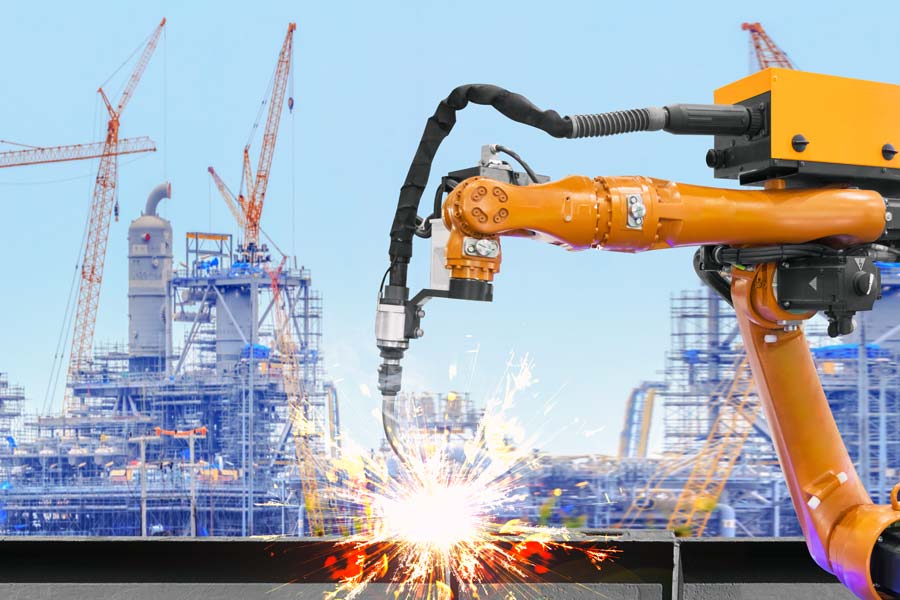Important as the construction industry is in bringing benefits to societies and economies around the world, the sector is more behind the curve when it comes to adopting new methodologies, ways to boost productivity, efficiency and quality.
According to the Office for National Statistics, labor productivity in U.K. construction has been volatile in recent years, a situation the industry recognizes it needs to address.
The prospect of boosting output and raising quality standards lends itself to the construction industry adopting more up-to-date methods and embracing new working practices, including automation.
But how is this to be achieved? What kind of automation do we expect to see? Fixed? Programmed? Flexible? A mix of all three? Who will decide? For some, the number of options may be enough to make their head spin.
That said, change is definitely in the air. A leading advocate for a new mindset is Mark Farmer, who has often pointed out the need for the industry to improve its practices and get up to speed with new technologies.
The need for change
Farmer believes in developments like automation, but has said that until the entire breadth of the construction sector is on board and recognizes what is at stake, progress will inevitably be painfully slow. He argues the industry will need a new palette of skills, along with the will to develop them.
There has been progress, of course. The urgency to build more new homes, for example, has heightened the industry’s drive to use modern methods of construction.
Pre-assembled steel frames or modular units are constructed by the likes of Ilke Homes and others using various forms of automation in the safe and secure environment of a factory. These are then delivered and installed on-site faster than homes built from scratch, saving time and money and resulting in occupiers being able to move in more quickly.
In the world of architecture, automated design meanwhile takes care of the dull and repetitive tasks normally done by human beings, freeing up designers to spend more time doing what they do best, namely being creative.
Elsewhere, sharing information digitally has gradually increased, enabling different teams working on a project to access crucial information at the same time. Enhancing the collaborative element of a scheme can make the difference between success or failure when it comes to delivering on schedule and within budget.
But can automation be a catalyst for change in construction the same way it transformed the automotive industry, where robotic technology revolutionized the way cars are built?
Modernizing the industry
Mark Farmer stresses automation can play a hugely significant role in modernizing the construction industry, although he believes there is perhaps too much focus on the technology or processes themselves, and that this needs to be rebalanced with a new digital skills agenda in all parts of the industry.
That said, there are some who appear to have already taken to automation in a big way. York-based Construction Automation Ltd. claims to have put up the first brick-and-block-built house using robot technology in the U.K.
The firm says its aim is to automate the building of brick-and-block homes, with company director David Longbottom claiming its four-part Automated Bricklaying Robot “increases productivity, improves health and safety and guarantees quality.”
Houses built by Rob(ot) The Builder? Lest some think this heralds the demise of the traditional bricklayer, the Association of Brickwork Contractors poured cold water on the idea.
Job losses?
Yet, the rise of automation in the construction industry will inevitably raise the specter of human job losses. After all, this is precisely what happened during the first Industrial Revolution in the late 18th century, when new spinning machines filled the mills of northern England.
Few actually believe the implementation of robotics and other forms of automation will drastically reduce its worker numbers. One website suggests that there is “very little” chance of civil engineers’ jobs being overrun by robots or artificial intelligence.
And while automation may indeed reduce numbers in some areas, shifts in employment practices will lead to new opportunities.
Global management consulting firm McKinsey believes automation is less likely to diminish employment opportunities “than it is to increase productivity.” Alongside the global need for new and updated infrastructure and better and more affordable housing, McKinsey reckons automation can help shape the direction of the industry. But it will take effort, it adds.
One thing is clear: change is inevitable. And it has to be, if the construction industry, steeped as it is in traditional ways of doing things, can meet the growing demand for new and innovative buildings that respond to their occupants’ needs.











